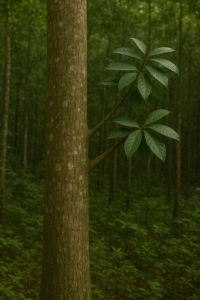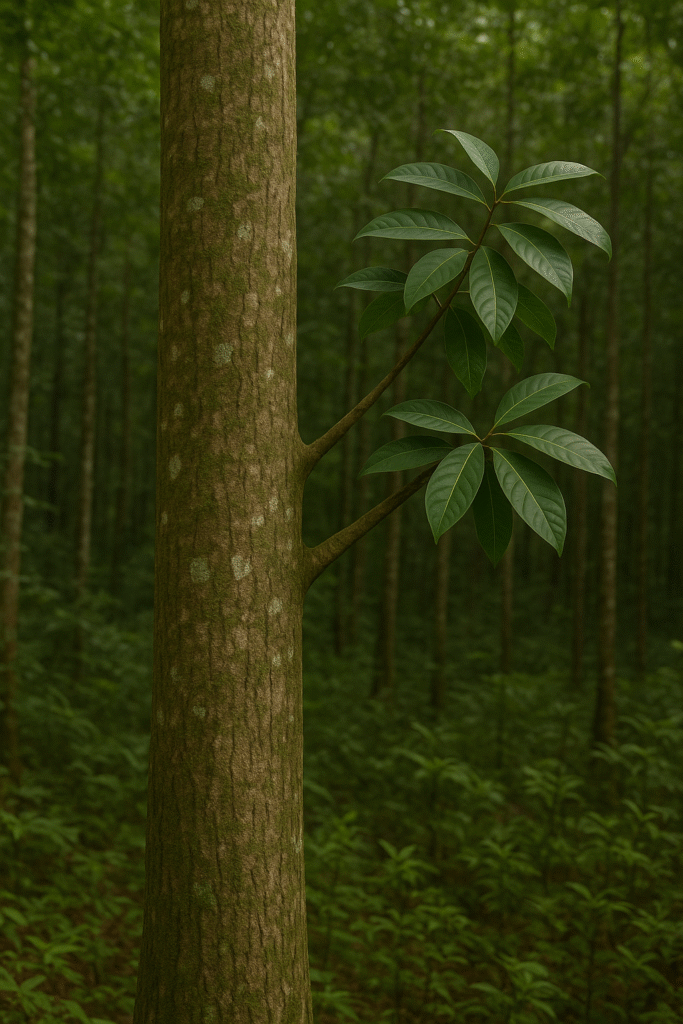Amapá is one of the lesser-known treasures of the Amazon rainforest. While the name might remind you of the northern state of Brazil, here we’re talking about a medicinal tree with significant cultural and therapeutic importance. Known for its thick bark and milky-white latex, this species hides secrets that have been studied for centuries by traditional communities and, more recently, by science.
In this article, we will reveal 10 mysteries about amapá that will change the way you see this incredible tree. Get ready to learn about little-known properties, traditional uses, and fascinating curiosities.
1. The true name of amapá
Few people know that “amapá” is not the scientific name of the tree. There are different species popularly called amapá, such as Parahancornia amapa and Brosimum parinarioides. Each has unique characteristics, but both produce latex with medicinal uses. This mix of popular names is one of the first “mysteries” that even confuses beginner botanists.
2. The white latex turned into medicine
One of the most curious aspects of this medicinal tree is its white latex, similar to milk. In Amazonian traditions, it is used as a natural tonic, helping treat anemia, weakness, and even respiratory problems. This practice comes from centuries of popular observation but is also drawing scientific interest for its bioactive compounds.
3. An ally against respiratory diseases
Another intriguing mystery is the potential of this Amazonian tree to support respiratory health, including conditions such as asthma and bronchitis. In the Amazon region, local communities often prepare infusions from its bark or drink diluted latex to ease breathing difficulties. Although further clinical studies are necessary, early findings suggest promising anti-inflammatory and expectorant properties.
4. The cultural strength of amapá
Medicinal amapá is not just a therapeutic resource — it’s part of the cultural identity of Indigenous peoples and riverine communities. In some regions, latex extraction is carried out with rituals and deep respect for the tree, reinforcing the sacred relationship these populations maintain with nature.
5. The mystery of the tree’s longevity
Some amapá specimens easily surpass 100 years of age. Their resistant wood and deep root systems allow them to survive floods and long droughts in the Amazon. This natural resilience is one reason why the tree remains a trusted medicinal source for generations.
6. A forgotten superfood
Few people realize that amapá’s latex contains vitamins, minerals, and proteins in significant amounts. In times of food scarcity, Amazonian communities use this tree as a natural supplement. This is why it’s sometimes called the “milk of the forest.”
7. Confusion with the state of Amapá
Perhaps the most curious mystery is the confusion between the tree’s name and the Brazilian state. Many believe the tree grows only in the state of Amapá, but in reality, it is found throughout the Amazon region, including Amazonas, Pará, and even neighboring countries like Peru and Colombia.
8. Its secret role in perfumery
Although medicinal use is the most recognized, amapá’s latex and bark are also used in artisan perfumery. Its soft, sweet aroma is used by Amazonian craftspeople to create exclusive fragrances — a little-known fact outside the region.
9. Potential in the pharmaceutical industry
Recent research shows that amapá may be a source of antioxidant and anti-inflammatory compounds. This opens the door to developing herbal supplements and medicines, potentially turning this tree into a high-value export product.
10. The risk of disappearing
Despite its importance, amapá faces threats such as deforestation and uncontrolled exploitation. Without sustainable management, entire populations of this species could be at risk. This is one of the greatest mysteries to solve: how to preserve medicinal amapá without preventing the communities that depend on it from using it.
Main benefits of amapá
-
Natural tonic
-
Helps with respiratory diseases
-
Source of essential nutrients
-
Cultural and ritual significance
-
Cosmetic and pharmaceutical potential
How to use amapá safely
Traditional use of the latex and bark is generally safe in small doses, but it is essential to consult a health professional before starting any treatment. Excessive use may cause stomach discomfort and other side effects.
Conclusion
Amapá is a true Amazonian treasure, full of stories, benefits, and mysteries. From Indigenous culture to modern scientific research, this tree proves that nature still holds precious secrets. By learning about and valuing amapá, we take an important step toward preserving not only a plant but also a cultural and medicinal heritage of the Amazon.

Enjoy Maximum Comfort on Your Camping Trips
The OGERY Sleeping Pad is 6″ extra-thick, reinforced, and designed with built-in pillows and a foot pump.
Perfect for tents, hiking, and outdoor adventures — it’s ultralight, self-inflating, and built to last.
Discover the Rubber Tree That Changed the World
Learn the fascinating story of the Hevea brasiliensis, the tree whose latex revolutionized industries worldwide.
Explore its history, uses, and impact in our detailed article.

